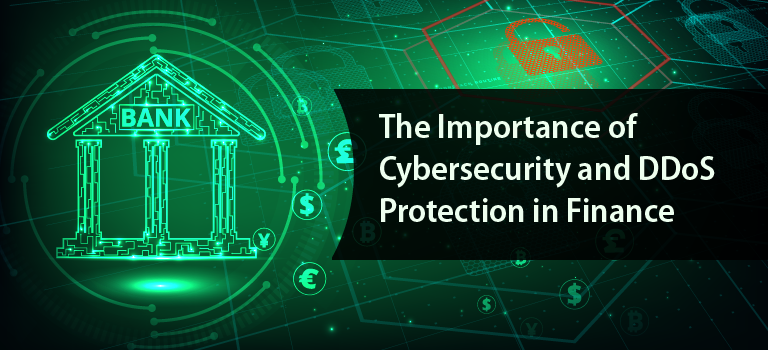The financial services sector is one of the biggest industries at risk, particularly after the COVID-19 pandemic and the boosted digitalization of business and personal finances. Banking is no longer a brick-and-mortar business; banking is digital, it’s mobile – 24/7, around the globe, which provides cybercriminals with more attack surfaces.
Lately, we have seen cybercriminals attacking not only banks, card issuers, and industries most prone to Distributed Denial of Service (DDoS) attacks, but all kinds of financial institutions and finance businesses payroll companies. We’ve also seen bad actors attacking crypto exchanges, which are often developed with limited security arrangements in a rush to follow a cryptocurrency trend. In the end, we are looking at different digital business models and online presence. As the business model becomes more digital, the incentive for attacking increases due to the obvious dependency on available IT. If the business model is highly vulnerable, there may be a greater willingness to pay a ransom – according to the attackers’ calculations.
Of course, abusing weak security is one of the easiest tasks for bad actors. Further, many of them can — and will — go for larger financial institutions, as they can obtain the most profit from them. Oftentimes, DDoS attacks get used to drain a business of its digital resources.
A DDoS attack utilizes IT firepower by hijacking manipulated cloud accounts or an army of IoT devices called botnets to flood the target’s servers with an amount of incoming traffic that can’t be processed in time. Consequently, legitimate users can’t access the services when the target’s resources are being knocked off by the attack.
Effects of a DDoS attack
As a result of a DDoS attack, financial institutions can become inoperative. This often entails a significant loss of money for these companies, especially if they can’t recover from the service outage promptly. They can also be economically affected by damaging the brand, eroding trust, and triggering subsequent lawsuits.
There are many factors at play that can cost the targeted company money or cause it to lose revenue. In fact, the average cost of a DDoS attack for financial institutions is calculated to be up to $1.8 million according to a whitepaper released by IRIS.
Additionally, financial service companies can suffer from damages to their brand in terms of a loss of reputation, trust, or credibility. After a DDoS attack, clients and investors will inevitably ask themselves if their money is actually safe. Even if a DDoS attack is not meant to steal a cent from a financial firm or its customers, a hacker’s success reveals a security breach in the company’s system that can create a sense of uncertainty among its users, even after it’s fixed.
That said, DDoS attacks are mostly driven by money, particularly in the financial service, which is very lucrative for cybercriminals. In fact, adversaries can use DDoS attacks as extortive means to demand payment from financial institutions, knowing that having their operations disrupted is more harmful to them than to firms in other sectors. Nonetheless, businesses in other industries aren’t safe from these attacks either. This just means that companies in the finance industry might have a bigger incentive to comply.
Moreover, DDoS attacks are increasingly used as a smokescreen to camouflage a wider-ranging cyber-attack to keep a company’s security team busy. For example, they can install malware, or they can install bots to launch mining codes.
Prevention is better than cure
Nowadays, security tools can rapidly become obsolete. Cybercriminals are constantly updating their approach and developing new tools to carry out cyber-attacks that slip past professional detection methods. Therefore, financial institutions should aspire to improve what we call “cyber resilience” — a broad term that describes a company’s ability to keep up its normal operations and processes, maintaining business continuity even during cyber events.
To achieve cyber resilience, finance companies must prepare for such events before they happen, learn what to do if they happen despite their best efforts, and have a plan to deal with the after-effects of the event. Overall, it is essential for any company to have an optimal IT security structure that can withstand penetration tests in the context of a complete security audit.
These ethical hacking procedures help IT managers identify security issues and fix vulnerabilities before cybercriminals can take advantage of them. Oftentimes this is not enough as hackers might still be one step ahead.
Finance businesses can then opt for additional web and infrastructure DDoS protection systems that rely on automation and AI systems that specialize in pattern recognition, as the combination of these two elements leads to faster DDoS detection and allows human resources to spread to other areas where they are most needed.
Providing a future proof DDoS protection solution
There is no doubt that digitization and networking in the financial sector will continue to advance. This makes banks and financial service providers all the more vulnerable to attack. Therefore, companies in the financial sector need to have the highest possible level of cyber resilience. By this, experts mean the ability to maintain business operations and processes in the company even when cyber threats or other crisis situations arise, such as failed software updates or problems created by human error.
The required IT security strategies, which are both reasonable and effective, include testing the existing protection against new vectors and methods, as well as constantly questioning and simulating the worst-case scenario. In addition, automated DDoS protection solutions are needed to minimize weaknesses in the operational models as well as human error to ensure the necessary protection is in place. And finally, it needs forward-looking and self-learning technologies that are nimble and agile, and able to keep up with the evolving threat landscape.
Marc Wilczek
Tags: Cyber Attacks, DDoS, Financial Security, Fintech


